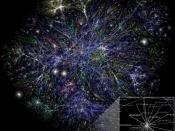Detection and Technological Protection Measures
Detecting unauthorized use of personal property is easier for tangible property than it is for intangibles as there are likely to be physical differences between the authorized and unauthorized copies. This provides a significant challenge to online trading of personal property. This combined with the broad range of problems associated with assigning of licenses over the internet has given rise to the desire for rights management systems.
Sophisticated rights management systems is a combination of scrambling of data so that only authorized persons may handle it (cryptography) and putting hidden cues in the data so that is people make unauthorized use of it that use may be evidenced (steganography) can work to secure online copyright. An instance has been the alliance between IBM and Xerox. As a result an image could be put in IBM's "Cryptolope", which could be sent to another person who would then have to pay to receive the key to unlock it.
This is where Xerox's Digital Property Rights Language (DPRL) helps by providing a language that allows content providers to electronically designate actions sanctioned by end users with respect to a specific intellectual property object.
Where matters are not subject to a rights management system, other modes of protection can be adopted. Technologies such as watermarking can come to use here. By identifying data such as copyright information into other data, watermarking helps detect unauthorized copy from the authorized ones. An imperceptible watermark is generated by using an algorithm to insert the data into an object, marking that object as proprietary. This watermark will act as evidence against the copier if the object is copied without satisfying certain conditions.
Imperceptible watermark may also contain information that allows other programs, sometimes called "bots" to track them when the copy appears...


